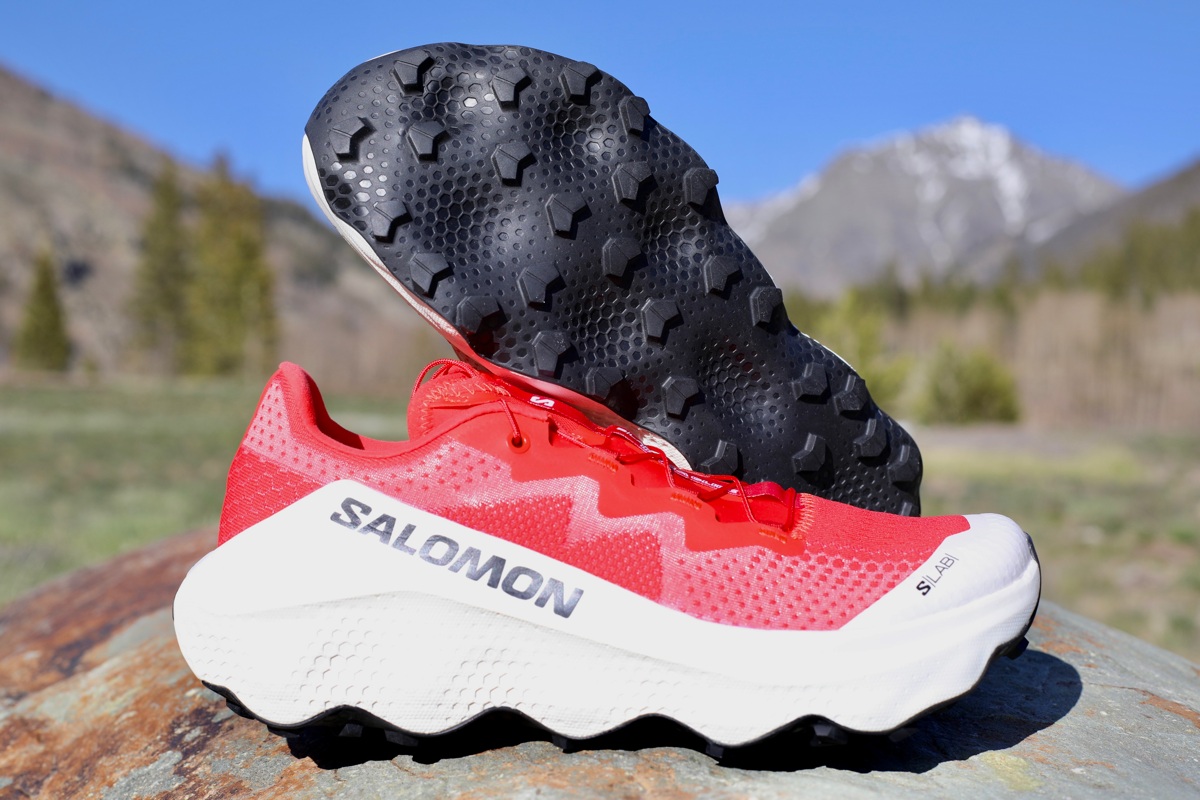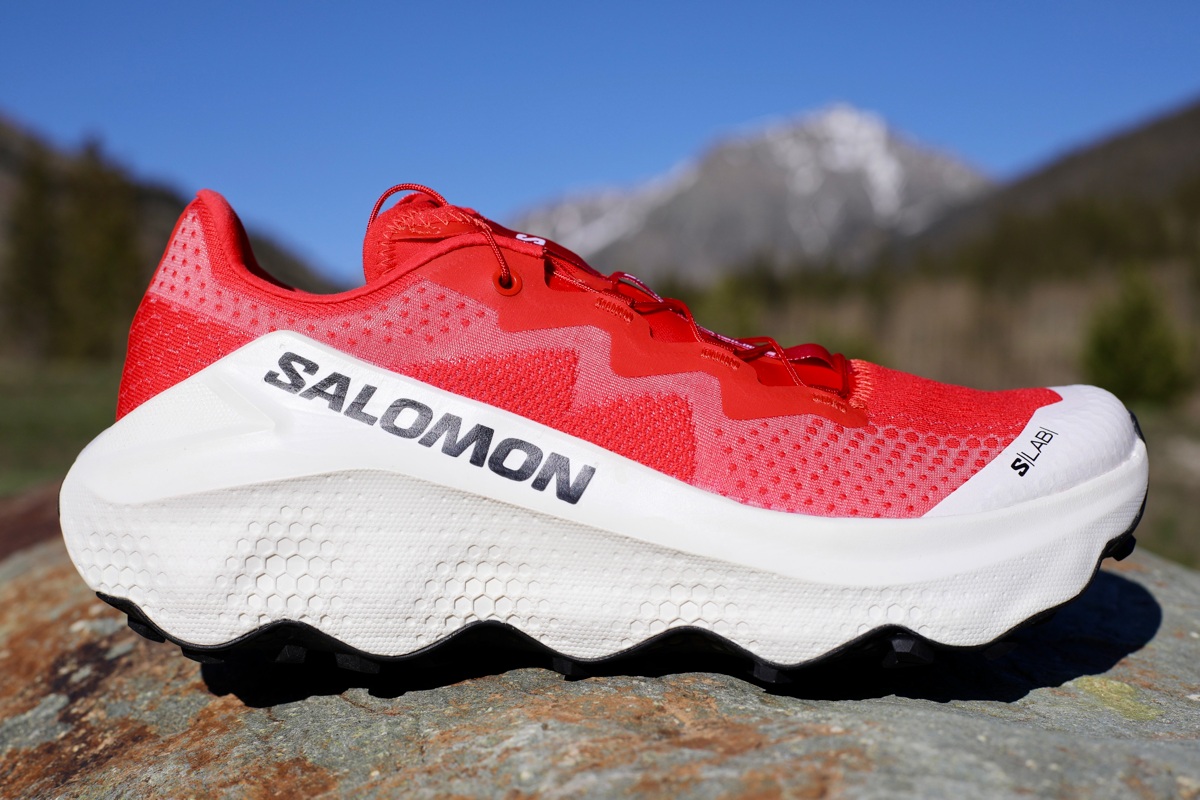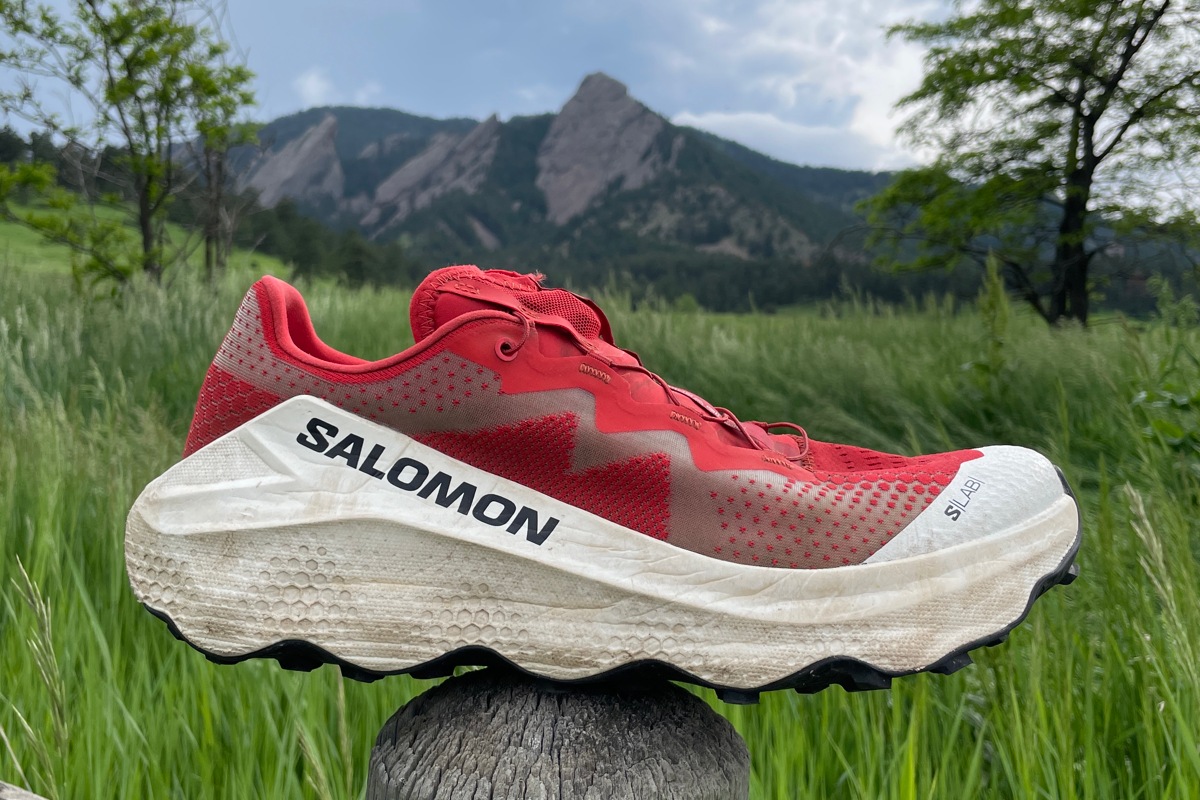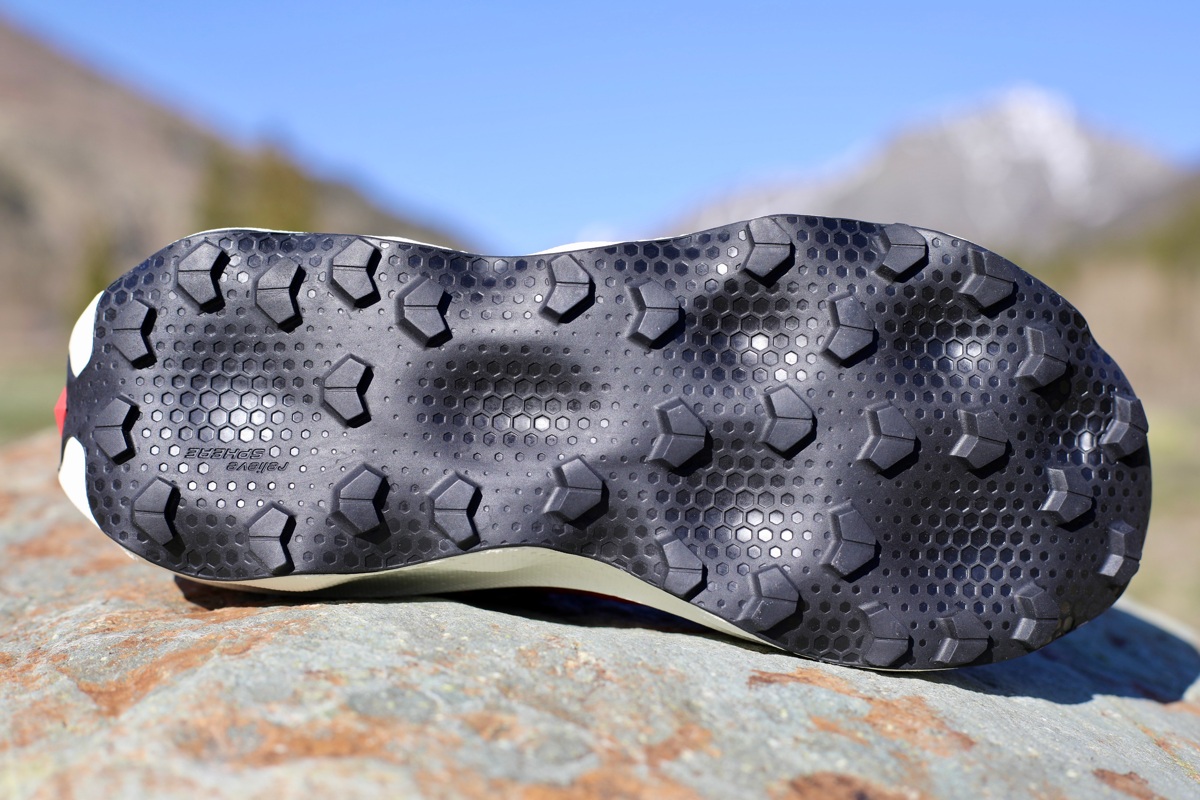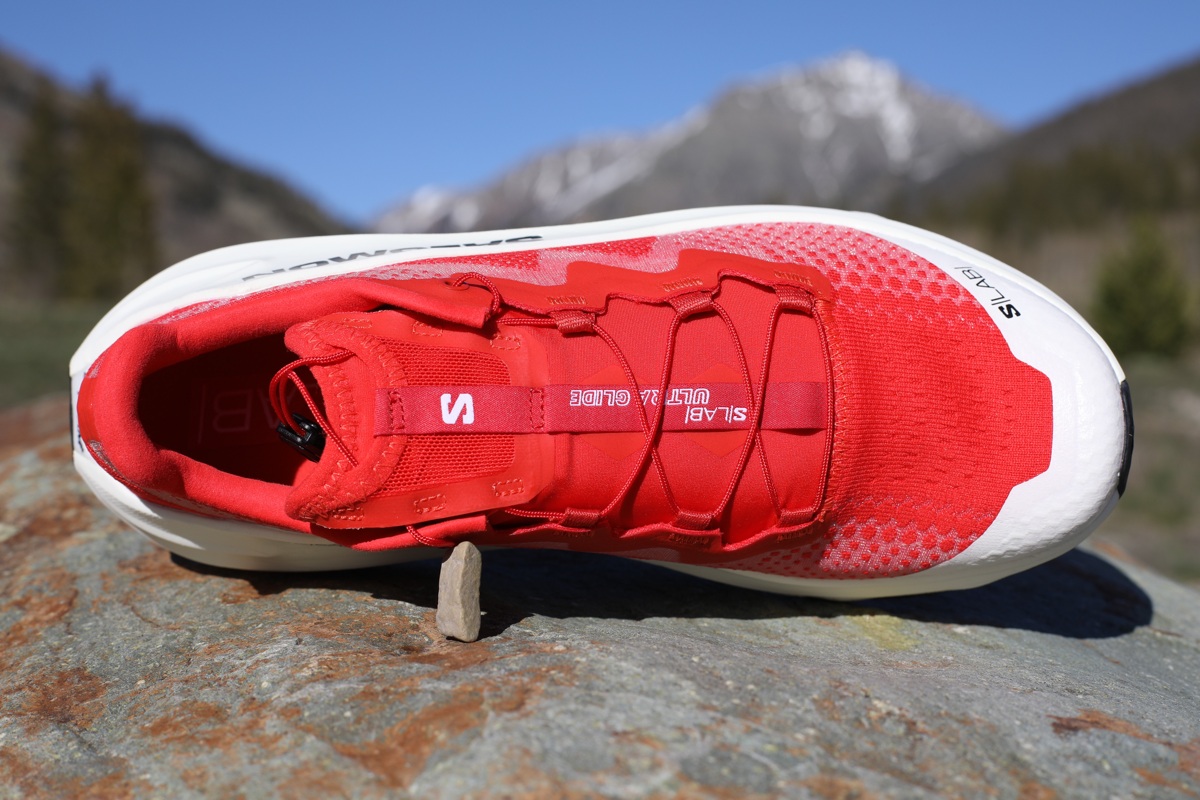Befitting of the “lab” in Salomon’s S/Lab moniker, the company invented some first-ever technologies and integrated them into the pretty experimental Salomon S/Lab Ultra Glide ($250) shoe.
The shoe looks strikingly different from anything else on the market and feels different than any of the other Salomon shoes I’ve tested over the last few years. Trail running shoe technology has largely centered on foams and plates lately and Salomon found a midsole combination that is as comfortable as any I’ve used.
But I’ll acknowledge my blind spots. One, for about five years now I’ve been particularly drawn to lightweight racing shoes, on the trails and on the roads. This has only been exacerbated by the incredible foam technology that has developed recently. Fast shoes are fun because of the energy return and bounce. The trails where I live are pretty balanced between very smooth and runnable and very steep and technical. Most of the time I can get away with higher stack, cush-y shoes, although I’m much more selective on race day.
My other blind spot is my testing of a wide swath of Salomon’s shoes. I’ve tested all of the Salomon S/Lab Pulsar models, of which there are four to date. The S/Lab Ultra Glide doesn’t share any traits with the Pulsar line, except for Salomon’s reserved red colorway, and yet this is a shoe I chose to review? Emphatically, yes!
Not surprisingly, the S/Lab Ultra Glide blends qualities from road super shoes — notably the same Energy Foam+ midsole used in the Salomon S/Lab Phantasm 2. The S/Lab Ultra Glide’s foam creates a high stack but with only average drop to help keep the shoe stable — a claimed 6-millimeter drop compared with the S/Lab Phantasm 2’s 9 millimeters.
With a claimed stack height of 41 millimeters in the heel and with all of that exposed foam — and, especially in my U.S. men’s 12.5 — the shoe cuts a massive profile. But looks do deceive. The immediate step-in feel is pure springy and super comfortable cushion. I was thrilled to have a highly responsive and rockered trail running shoe to balance my growing disdain for plated ones where with an equivalent amount of cushion, ground feel is just killed. This shoe’s high cushion doesn’t scream ground feel either, but without a rigid plate in the way, it is much better than some of similarly priced super shoes from The North Face, Hoka, and adidas.
But even by modern standards, this shoe is expensive and has some unsubstantiated technology, particularly in the outsole, that you might not want to pay for. That said, I think you’ll struggle to find a more comfortable and fun shoe for normal paces and, despite the “ultra” in its name, it is a blast to use whether you’re running just a few trail miles or many.
Shop the Salomon S/Lab Ultra Glide - UnisexSalomon S/Lab Ultra Glide Upper
Materially, the Salomon S/Lab Ultra Glide upper is straight forward. Breathable mesh wraps the shoe, from the forefoot and around both sides where it meets the Quicklace system. Unlike, say, the S/Lab Pulsar series, the Quicklace system here is unprotected, with the laces passing through stitched tunnels until a final eyelet where it terminates with the laces’ locking mechanism.
Quicklace has never been my favorite lacing system; it’s interesting that in this era of Boa dials, Salomon remains committed to its proprietary lace style. My issue with Quicklace is the inability to make micro adjustments at certain sections of your feet.
The typical lace garage covers the very top of your foot and prevents you from making micro adjustments, it feels like you have just two options: a little too loose, or a little too tight. The laces do a phenomenal job though staying in those positions, never becoming different from the setting you applied. I just wish there was more customization.
The upper material quality is great, with the mesh being durable and breathable, and reinforced — not with typical overlays — but with micro stitching meant to prevent abrasion while saving weight.
Because of its various stitching and patterning, the upper reminds me, aesthetically, of a European brand’s athletic compression sock with different zones and intentions.
The upper has remained in good condition throughout my testing, though one area of concern has already sprung up. The Quicklaces run over the ankle collar where it connects at the tongue. They are slowly grinding down the suede-like material and will most certainly become split open. This is in contrast to the material choice for the tongue itself. The gusseted tongue is made from a neoprene-like material, which is where the majority of the laces run over, and is clearly more durable to withstand their abrasion.
When you put the shoe on, even with the laces fully loosened, I found the tongue would get bunched up. Salomon must have had this issue as well and is addressing it with the dual pull tabs over the tongue. A lower one helps spread out across your forefoot and a top one, stitched over the lacing garage, helps distribute or even out any bunching.
While it’s really part of the midsole, a review of the upper should mention Salomon’s Energy Foam that extends almost as high as the ankle collar and is one part of the midsole stack. Its height is meant to cradle the medial and lateral aspects of your foot.
Salomon S/Lab Ultra Midsole
It is an incredibly pleasant experience to put on the Salomon S/Lab Ultra Glide and sink into the foam. I’m a lightweight trail shoe disciple, so in order to find enjoyment out of a heavier and less nimble shoe, the midsole construction must be lively, fun, and cushy.
The shoe’s huge stack — a claimed 41 millimeters in the rear and 35 millimeters in the forefoot — especially in my U.S. men’s 12.5 presents a huge overall package and footprint.
With an actual weight of 11.0 ounces (313 grams) for a U.S. men’s 9, the shoes I immediately likened the S/Lab Ultra Glide to were the The North Face Vectiv Pro 3, which have a claimed stack height of 43 to 37 millimeters, heel to toe, and a claimed weight of 10.4 ounces (294 grams) for a U.S. men’s 9, and the Arc’teryx Sylan Pro, with a claimed stack height of 28 to 22 millimeters and a claimed weigh of 10.2 ounces (289 grams) for a U.S. men’s 9. All of these shoes utilize an extremely rockered shape, so they slot in as well as trail running shoes-cum-bulldozers/tanks/Humvees … you get the idea. I think the On Cloudultra Pro will also find company with this trio, although it may fancy itself more race-worthy than any of the aforementioned.
In true S/Lab form, the midsole leverages some new ingenuity and design characteristics with its first-ever four-part construction. The midsole componentry is as follows: directly underfoot sits an Energy Foam top layer, made of the now industry standard PEBA super foam, atop a two part interlocking carrier layer made of EVA foam that creates a giant sidewall that helps stabilize and lock-in the foot. Finally, a “relieve sphere” layer of body-mapped dimples designed to relieve pressure in the foot create the outermost layer.
Salomon invited some media (although not me) to see the Salomon S/Lab Ultra Glide in France last summer and had bits of the midsole on display; it’s worth Googling to find these images and see how this midsole package comes together. It’s quite striking. The two-part carrier foam extends high on the sidewalls of the medial and lateral aspects of the shoe; it’s the exposed white sections you can see on the outside of the shoe. These two independent pieces are glued together down the middle; the extended sidewall portions help with stability and lock down.
It’s a fascinating design process surely adding cost to this already very expensive shoe, but does it enhance the performance and impression while running? Perhaps not in the way the brand was intending. You don’t really feel anything so proprietary or unusually beneficial that you’re left thinking the shoe stands out in a material way, it’s just a very enjoyable sensation that continues the trend of giving road shoe bounce and efficiency to durable, lugged shoes for trail.
The S/Lab Ultra Glide is also lovely to use in road-to-trail situations since the foam is springy and soft on concrete, without super deep outsole lugs dragging against the pavement.
The cost would suggest one, but the S/Lab Ultra Glide has no carbon or nylon plate. Perhaps not coincidentally, a research paper published recently by two Salomon employees testing found that carbon-plated trail running shoes may not be as effective as we believe. iRunFar summarized the research. In some trail shoes, a carbon plate not only helps with energy transfer but also with protection, giving a rigid layer of impenetrable coverage. I found the lack of plate to be unnoticeable in terms of underfoot coverage against sharp rocks on the trail.
Salomon S/Lab Pulsar 3 Outsole
In a shoe full of surprising details, it’s the outsole of the Salomon S/Lab Ultra Glide that arguably is the most compelling. See above “relieve sphere:” this dimple pattern lines the outsole around a smattering of 4-millimeter Contagrip lugs. My near-everyday running trails’ surface is smooth and rolling — the perfect application for this shoe. When I run some of Boulder’s iconic systems like Shadow Canyon, Mount Sanitas, or Fern Canyon, however, it’s an entirely different experience.
Done slowly, the shoe contours and finds its footing on these extremely steep and technical trails, but when you add speed, the outsole’s wavy, uneven patterning makes for a clumsy adventure. Folks have middling experience with the effectiveness of Contagrip, but because there are relatively few lugs on this shoe in the first place, over time, the outsole effectiveness might be compromised without a way to repair it. Something like a resoleable option from Vibram would be a good solution, though imagine the tooling needed for that.
Salomon S/Lab Ultra Glide Overall Impressions
I was extremely happy with the fit, comfort, and aesthetics of the Salomon S/Lab Ultra Glide. It hampered my very wide, bunion-laden feet not at all. It provided soft comfort against a lingering metatarsalgia issue I’ve been having on my right foot. Though I’ve raved in the past about the S/Lab Pulsar line, I have a silent compact with those shoes: you give me speed now, I’ll pay the price with NSAIDs and ice packs later. I knowingly opt in to the pain they might provide because I like the speed I can generate. The S/Lab Ultra Glide breaks the S/Lab mold with its roomy and cushy, dare I say wide-ish forefoot, making it the comfortable, albeit, slower counterpart to the Pulsar range.
Similar to how I’ll reach for the Altra Olympus 6 when I want to comfortably ramble along for a long time, I think the S/Lab Ultra Glide will fall into similar situations. It’s perhaps way too pricey to be relegated to just these runs, but if I were racing and could only choose between the Olympus and Ultra Glide, I’d definitely choose the latter. Unfortunately, a bevy of other shoes would knock out the Ultra Glide for consideration for racing; for fun, cruisy runs though it’s a top pick. Salomon has a lot to work with in this first edition of the shoe. Perhaps a v2 will smooth out some of the outsole quirks and hopefully address some of the weight-bearing aspects, like the upper and the nice but maybe unnecessary midsole componentry.
Shop the Salomon S/Lab Ultra Glide - UnisexCall for Comments
- Have you tried the Salomon S/Lab Ultra Glide? What were your thoughts?
Our Favorite Trail Running Shoes
Learn more about our current favorite trail running shoes in our Best Trail Running Shoes guide.
